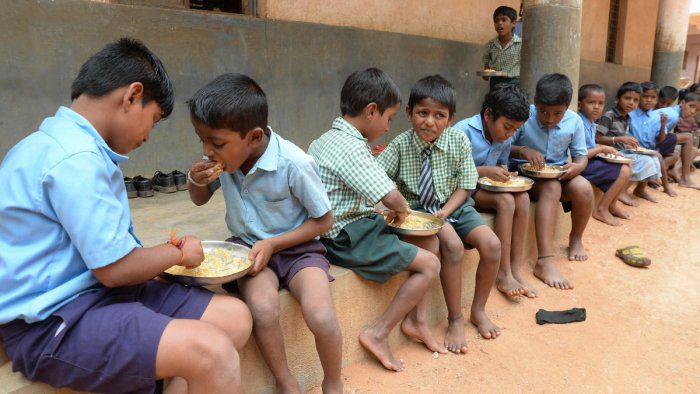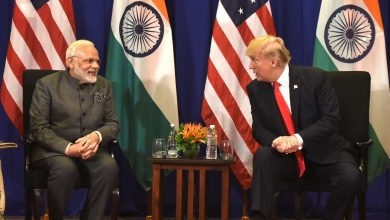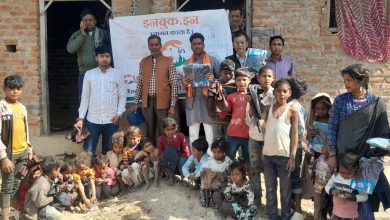Undernutrition caused by the cereal monopoly
After every visit to the Public Distribution System (PDS) outlet, Shantamma sits on her porch in a village in Chikkaballapur, Karnataka, picking out husk, rocks and other impurities. The slightly discoloured grains of rice she is throwing away are fortified with nutrients, but she does not know this.

After every visit to the Public Distribution System (PDS) outlet, Shantamma sits on her porch in a village in Chikkaballapur, Karnataka, picking out husk, rocks and other impurities. The slightly discoloured grains of rice she is throwing away are fo…
In an effort to counter malnutrition, the Union government introduced rice fortified with iron,
folic acid and vitamin B-12 in the country.
Like Shantamma, many in her village are in the dark about the rice that they are eating. They
are unaware of the controversy surrounding fortification and the dangers it could pose to
people with certain illnesses.
With a monthly income of Rs 9,000 and a family of four to care for, Shantamma
acknowledges that the PDS provides rice and ragi, but it is not enough. “Can we go to sleep
with just rice in our stomachs? We need to spend money on vegetables, oil, sugar and
pulses,” she says.
Close to 71 per cent of India cannot afford healthy meals, according to a 2022 report by the
Food and Agriculture Organisation (FAO). A diet becomes unaffordable when it costs more
than 63 per cent of a person’s income. India fares worse than countries like China (12 per
cent) and Brazil (19 per cent)


A study by the Centre for Science and Environment found that 1.7 million in India die every
year due to diseases caused by a poor diet. These figures only show that the country’s food
programmes need to begin addressing nutrition insecurity, rather than singularly focusing on
food security.
Mallikarjun, an agricultural labourer in Chikkaballapur, says that the recent rise in food prices
means that his family shops for vegetables and meat fewer times in the week. Fruits are out
of the question. “With no land to cultivate vegetables, we are forced to buy what we cannot
afford. We have just started eating less vegetables,” he says.
About 60 per cent of Indians receive foodgrains through the PDS — a majority of states are
supplied with rice and wheat. While the cereal-heavy programme might meet caloric
requirements, it masks serious nutritional deficiencies.
The green revolution increased the country’s dependence on cereal. Overcultivation of cash
crops, and the decline of millets, has contributed to the crisis. There is a need to diversify
food crops immediately.
This is evident in the nutritional status of ration cardholders, who score poorly across all
indicators. A 2019 study by a private consulting firm assessed the nutritional gaps in
households that consumed foodgrains received through the PDS.
The study revealed that all beneficiaries – men, women, pregnant and lactating women and
children – had low levels of basic macro and micronutrients. This included serious
deficiencies in protein, fat, calcium, iron and folic acid.
The study expounds that only 18 per cent and 20 per cent of the protein needs of men and
women were met through government programmes. Pregnant women, lactating mothers and
children, who avail nutritional supplements through the Integrated Child Development
Services (ICDS), fared comparatively better. However, at least 50 per cent of their protein
needs still went unmet.
Why do these programmes fail to address nutritional insecurity? The problem, experts say, is
with the lack of dietary diversity
Monotonous diets
“We are only providing people with cereal. The body needs more than just carbohydrates – it
needs pulses, legumes, eggs, oil and meat. It needs variety,” says Dr Veena Shatrugna,
former deputy director of the National Institute of Nutrition, Hyderabad. There are more than
20 micronutrients that the body needs, she explains.
Most micronutrients are available naturally in legumes, greens, fruits, dairy, egg, meat
products and oils, which remain out of reach for many deprived communities.
“Though the PDS comes under the justiciable right to food, many people, including the
government, view it as a charity initiative. They think something is better than nothing,” says
Dr Vandana Prasad, a Delhi-based community paediatrician and a public health expert.
It is natural to crave variety, experts say. To satiate this craving, many people have come to
depend on biscuits, chips and other ultra-processed foods. “My child cries if I don’t give him
something with his rice, so I end up buying biscuits or chips to go along with his food,” says
Geetha (name changed), a construction worker in Bengaluru.
An excess of these easily available snacks with a cereal-heavy diet can cause obesity and
trigger non-communicable diseases like diabetes and hypertension. India already suffers
from a diabetic problem of epic proportions with 74.2 million afflicted with the disease. It is
only surpassed by China.
Cereal-heavy diets can also hide malnutrition and keep people from seeking out treatment.
“Several studies establish that the effects of undernutrition are severe, affecting thinking,
intelligence, cognition and daily activities,” says Dr Prashant N S, assistant director at the
Institute of Public Health, Bengaluru.
According to the World Bank, India loses up to US $12 billion annually due to vitamin and
mineral deficiencies.
Rice fortification
The latest ‘silver bullet’ to tackle anaemia caused by malnutrition is rice fortification. In his
Independence Day address last year, Prime Minister Narendra Modi announced that rice
supplied under all schemes would be fortified by 2024.
The move was not received well by experts, doctors and nutritionists, who have called into
question the evidence, effectiveness and ethics behind the decision.
Evidence to support the effectiveness of fortification in tackling anaemia is nebulous. An RTI
query submitted to the Indian Council of Medical Research – National Institute of Nutrition (ICMR-NIN) found that both fortified rice and regular rice in midday meals had a similar effect
on the reduction of anaemia.
Contemporary research also calls into question the high stipulation of iron requirements in
the past. “The daily requirement for iron as a nutrient was thought to be very high (before
2020). One could not possibly meet this through a normal diet. Such a situation brings up the
need for fortifying the diet,” says Dr Anura Kurpad, professor of physiology and nutrition at St
John’s Medical College, Bengaluru. In 2020, new research revealed that a regular, diverse
diet could sufficiently meet iron requirements.
Focus on individual
For those who do suffer from vitamin and mineral deficiencies, a clinical approach is vital.
The PDS, which is designed to count households as units, and not individuals, is insufficient
to address malnutrition. “A case management approach is the right way to address nutritional
deficiencies. A clinical intervention, with doctors who can monitor and stop dosages, is safe,”
says Kavitha Kuruganti, of the Alliance for Sustainable and Holistic Agriculture (ASHA),
who was part of a recent fact-finding visit to Jharkhand on rice fortification.
The fact-finding report observed that fortified rice could be dangerous for people who suffer
from thalassemia, sickle cell anaemia, malaria, tuberculosis and even those with severe
acute malnutrition. Even people who have the genetic trait and not the clinical disease could
absorb an excess of iron and be at risk.
Kapil Mohan, Additional Chief Secretary of Food and Civil Supplies, Karnataka, explains,
“This is only a miniscule amount of the population. The programme will benefit the majority.”
It is unclear if those with thalassemia and sickle cell anaemia were informed when they were
provided with fortified rice. There is also uncertainty whether alternative options will be made
available to them at PDS centres.
In conversation with DH, a PDS dealer, on the condition of anonymity, said that there were no
information campaigns about fortified rice in Chikkaballapur. “Vendors like me attended an
informational session conducted by the District Commissioner. I only explain to consumers
when they ask me about the fortification process,” he says. A vast majority does not ask.
A lack of effort to raise awareness is a grave violation of citizens’ rights to make informed
choices. “Citizens should have the first say in what they consume. Their food choices should
not be dictated. The government must take a collaborative approach,” says Dr Prasad.
Unscientific approach
There is also a tendency to attach a notion of ‘impurity’ towards meat-eating. “There is a push
towards vegetarianism that is proving discriminatory towards minority, tribal and scheduled
caste communities. For instance, traditionally, many marginalised communities consumed
beef which is a cheap and nutritious source of protein and iron,” says Dr Prasad. However,
restrictions on beef consumption exist in 20 out of 28 states.
Meat products have high biological value, since they are rich in protein, iron, vitamin B-12,
zinc, selenium and phosphorus. Nutritionists have long advocated for the inclusion of eggs in
midday meals due to their high protein, vitamin and mineral content.
A parent in Bengaluru who receives eggs for her five-year-old daughter through ICDS says,
“My daughter goes to the anganwadi for the eggs. She can eat anything with eggs,” she
says. Yet, in a country with a meat-eating population of 70 per cent, only 13 states and 3
union territories provide eggs in midday meals.
Even Karnataka, which started providing eggs in seven districts recently, came out with a
National Education Policy position paper that suggests a ban on eggs and meat in midday
meals. It claims they lead to ‘lifestyle disorders’.
Attaching morality to food and nutrition can be extremely detrimental. “People are free to use
religion as a justification for their own food choices but not to thrust it upon others,” says Dr
Prasad
Way forward
“Food cultures have evolved over long periods. Kitchens were once nutritionally rich places
because of the many different varieties of grains, meat, vegetables and fruit,” says
Kuruganti.
Cultivating a holistic diet is inextricable from agricultural diversity. Local food crops, such as
millets, have retreated from farms following the green revolution. The lack of crop variety,
owing to the rapid expansion of commercial and cash crops, has contributed to poor diets.
“A serious effort needs to be made to diversify India’s food basket, and to protect farmers
who grow diverse foods, rather than just cereals,” concludes Dr Kurpad.
Without sufficient evidence and stakeholder involvement, the fortified rice project becomes a
one-size-fits-all solution. This ignores cultural diversity and nutritional requirements.
A sound way forward is to adopt a collaborative, decentralised approach. There is a need to
empower citizens to make informed choices. Communities have a right to access and
consume diverse foods through a public distribution system that makes this possible.
This news has not been edited by our staff and has been posted to keep the users updated about the things happening in and around the world.






